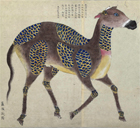Japanese Archaeology and Special Exhibition (Heiseikan) Thematic Exhibition Room
April 10, 2012 (Tue) - May 27, 2012 (Sun)
The long-necked animal, the giraffe (in Japanese, kirin), first came to Japan in 1907, although a stuffed specimen was displayed at this museum in 1877. Japanese paintings of giraffes began earlier, from the end of the 18th century, with their source being a giraffe taken from Africa to China in 1419. However, by the 5th century BC in China, and by the 8th century AD in Japan, depictions of another animal called “kirin” had already appeared. This kirin is the Qilin, the theme of this exhibition.
A Qilin is a curious-looking animal, with the body of a deer, tail of an ox, hooves of a horse, one horn on its head, and five-colored fur. Some say it lives for a thousand years, others say three thousand, but the Qilin cannot be seen all the time; it is said to appear only when the world is governed well. As you have probably realized, Qilin are imaginary animals, like dragons, phoenixes and Chinese lions.
Qilin have appeared in artworks as auspicious symbols since ancient times. There are even Qilin depicted on treasures of the eighth-century Shosoin Repository in Nara. In Japan, it is rare for a Qilin to be the focus of an artwork, with most appearing as decorative patterns or adornments. Notable exceptions are the Qilin in the scrolls, Caricatures of Frolicking Animals and People, produced in the late Heian period (794-1192) and owned by Kozanji temple, Kyoto.
This exhibition introduces works featuring Qilin and other mythical creatures such as dragons and phoenixes, as well as representations of real giraffes created at the start of the Meiji era (1868-1912) and based on Western information.

